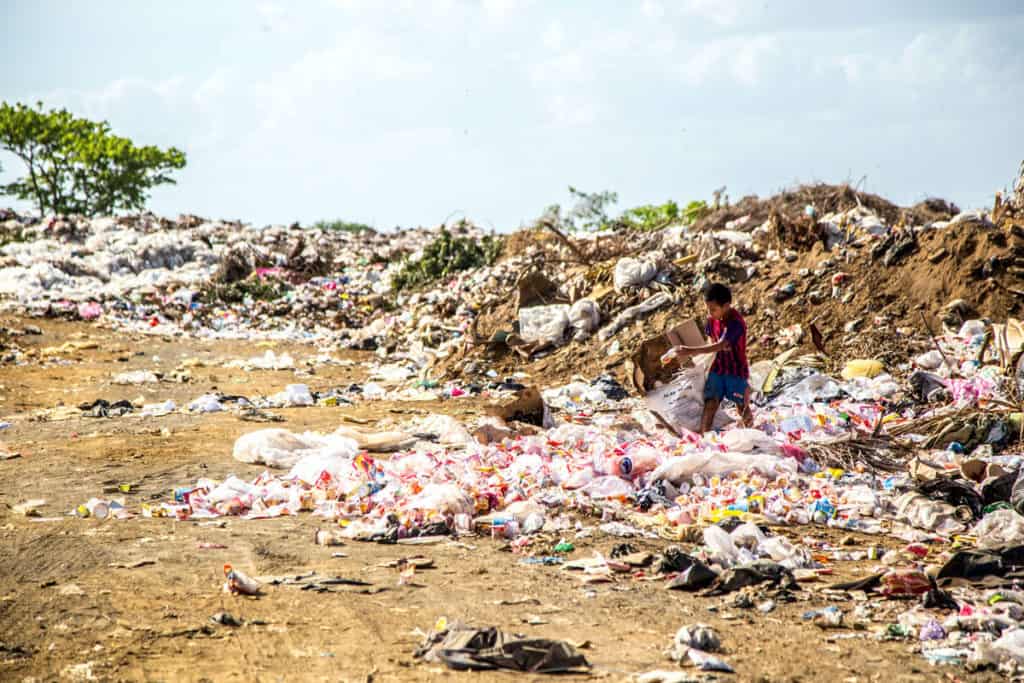Writing by IRA ARZ Photo by Hermes Rivera | Solen Feyissa
DECEMBER 21, 2021
One person’s trash is another person’s waste.
In Indonesia, 7,000 tons of trash arrive daily at a landfill more than 200 football fields wide and over 15 stories high, creating a giant trash mountain in Bekasi. [1] Every second, the equivalent of one garbage truck of textiles is landfilled or burned globally. Our planet is overflowing with an array of our textile waste, making up 7% of landfills, according to Make Good [2]. Consumer behaviour is the drive behind the growing number of waste polluting lands and oceans all around the globe. What’s more, during the Covid pandemic alone, retailers reported a 14% increase in online shopping among people under 30. [3] There’s no end to the limit of behavioural consumption, and so far, the numbers are rapidly going up.

One of the more recent images of this issue came into light when photo journalist Martin Bernetti shared horrifying images of the pile of clothes dune found in Chile’s Atacama Desert. The amount of clothes piled up was an estimated 59,000 dumped yearly, according to Aljazeera. [4] Amongst the pile, locals are found searching for used clothes, majorly polluted by fast fashion labels, made in countries such as China, Bangladesh and passing through Asia, Europe and then dumped in Chile before getting resold around Latin America.
It’s a major problem because clothes do not biodegrade well in landfill. “Even if they are made of 100% cotton they have a much better chance of breaking down buried in your backyard, than if you throw them in the trash surrounded by plastic and other household waste,” Make Good; on the Fashion industry’s problem with waste. Consumption patterns stand as one of the main struggles in reducing GHG footprint; “a predicted rise in volumes could push carbon emissions to around 2.7 billion metric tons a year by 2030 if no abatement actions are taken”. [5]
What does the future look like?
While many brands claim to implement sustainable models into their business, most are unable to show proof of how much change has been made within their company to contribute to reducing emissions. In reality, there has been little to no change in reducing retail operations and in encouraging ethical consumer behaviours by major fast fashion brands. Brands are not doing enough and are moving too slowly to achieve a more circular business model. Thus this problem largely lies with us — the individual.
What can we do now?
- Taking action against textile waste has the second-highest potential for reduction of greenhouse gas emissions compared to other recyclables.[6] The textile industry contributes to not just landfills, but also environmental degradation from the use of water and energy to produce textiles. And to accommodate the growing demands of consumers, it’s no surprise more clothes are being produced rapidly each day.
- Second-hand clothing waste in Accra, Ghana has turned into a public health crisis. With an overwhelming amount of unsold and returned clothes being sent there, the city is literally flooding due to textile waste. Clothing waste tends to end up in gutters and clog the flow of water and waste, resulting in life-threatening floods. [7]
- To deteriorate this pattern in the industry, we must change as consumers and lean towards a more sustainable approach to consumption. Before adding another piece of item to your wardrobe, ask yourself how many piles of clothing exist on this planet right now. And if your answer starts with a few thousand tonnes, then you might want to reconsider another alternative.
There’s more than enough clothes to go around in the world to keep you going for months, there’s no need for more to be produced. The textile recycling rate is currently one of the lowest compared to other materials, fabrics has a long life expectancy when treated well. Recycling or renting clothes are some of the ways to make the most out of one produced piece of clothing and encourage depletion in overproduction. Donating clothing to charitable organisations is a step towards keeping clothes out of landfills, and many can be found in any city nowadays.
Do you prefer recycling, swapping, renting, or donating your unwanted clothing? Let us know in the comment section below.
References
1. Nakamura K. 7 Genuinely Shocking Facts About Our Global Waste Problem [Internet]. 2021. Available from: https://www.globalcitizen.org/en/content/global-waste-facts-plastic-fashion-food/
2. MakeGood. The Fashion Industry’s Problem With Waste [Internet]. 2020. Available from: https://www.makegood.world/fashions-problem-with-waste
3. Strasser J. To Shop Sustainably For Clothing, Stop Shopping [Internet]. 2021. Available from: https://massivesci.com/articles/co2-emissions-clothing-manufacturing-fast-fashion/
4. Aljazeera. Chile’s Desert Dumping Ground For Fast Fashion Leftovers. 2021. Available from: https://www.aljazeera.com/gallery/2021/11/8/chiles-desert-dumping-ground-for-fast-fashion-leftovers
5. Berg A, Granskog A, Lee L, Magnus K. Fashion On Climate. 2020. Available from: https://www.mckinsey.com/industries/retail/our-insights/fashion-on-climate
6. Center for EcoTechnology. The Monster in our Closet: Fast Fashion & Textile Waste on the Rise [Internet]. 2017. Available from: https://www.centerforecotechnology.org/fast-fashion-textile-waste/
7. Lorenz J. Decolonising Fashion: How An Influx Of ‘Dead White Man’s Clothes’ Is Affecting Ghana [Internet]. 2020. Available from: https://eco-age.com/resources/decolonising-fashion-dead-white-mans-clothes-ghana/

